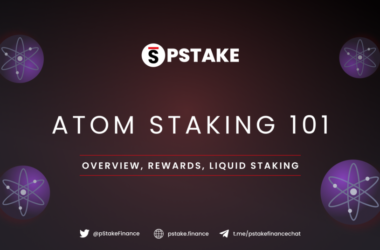Author: Fahad Sheikh
Note: This is a community-written piece. The views expressed within are those of the author and not necessarily those of the pSTAKE team.
If you are a crypto investor, then staking cryptocurrency is a concept you will often hear about, and you may be wondering what is staking cryptocurrency. Staking cryptocurrency is a process which facilitates the verification of transactions in a proof of stake (PoS) network, and allows participants to receive staking rewards.
Staking cryptocurrency involves locking your tokens in a smart contract to support the blockchain network and verify transactions. Staking cryptocurrency is only possible with those cryptocurrencies that use the Proof of Stake model to operate a blockchain. It is a more energy-efficient alternative to the original proof of work (PoW) blockchains. Proof of work requires large amounts of mining equipment like GPUs and ASICs that use a lot of computing power to solve mathematical equations. A PoS blockchain doesn’t need so much mining equipment, and mainly just requires users to start staking cryptocurrency.
Staking can be a great way to use your crypto to generate passive income, especially since some cryptocurrencies offer high rewards in terms of APY for staking cryptocurrency. Before getting started, it is essential to understand how crypto staking works fully.
How Does Staking Cryptocurrency Facilitate PoS Blockchains
Staking cryptocurrency uses the proof-of-stake model to add new blocks of transactions to the blockchain. First, stakers lock their tokens into a smart contract by delegating to a validator. From these the protocol randomly selects a validator to validate the transactions within each block. Generally, the more coins delegated to a validator, the more likely it will be chosen. There are also certain technical aspects involved in becoming a validator.
Whenever a new block is added to the blockchain, new tokens are created and distributed to the validator of that block as a reward. Usually, the staking rewards given out to stakers are in the form of the blockchain’s own PoS cryptocurrency, but some blockchains use a dual token system. In a dual token system the blockchain has 2 cryptocurrencies, one is for governance and utility, while the other is for staking rewards as well as some form of utility.
If you want to help validate blocks for your blockchain you will need to start staking cryptocurrency. Keep in mind you can’t stake all cryptocurrencies, you can only stake the blockchain’s own PoS cryptocurrency. An example of a PoS blockchain, and its PoS cryptocurrency are Persistence, and the XPRT token.
Staking your tokens requires you to lock them into a smart contract, which means you no longer have liquidity with those assets (unless you are liquid staking) and cannot immediately withdraw them from the smart contract. There is a certain level of risk you will have to undertake when you are staking cryptocurrency, so always make sure to use a safe, and audited staking platform like pSTAKE. Additionally, keep in mind that when you are staking cryptocurrency you will have to lock your tokens into the smart contract for a defined period.
Join a Cryptocurrency Staking Pool
An important part of understanding what is staking cryptocurrency involves learning about staking pools. Although staking cryptocurrency can work differently depending on the cryptocurrency you use, many stakers use staking pools. Using a staking pool allows stakers to combine the power of their staked tokens, which increases the chance of them winning staking rewards.
Before proceeding you should research the staking pools available for the cryptocurrency you have. Make sure the staking pool you use is safe, and audited before you start using it, because you will need to deposit your tokens into it. Staking platforms like pSTAKE offer a staking pool service. When picking a staking platform for a staking pool look for these 3 factors: reliability, fees and size.
Reliability: You do not receive rewards when your staking pool servers are down. Choose one like pSTAKE whose uptime is as close to 100% as possible.
Reasonable Fees: Most staking platforms charge fees for providing a staking pool service, and these fees are a percentage of the staking rewards you receive. Pick a staking platform that charges low fees for staking cryptocurrency.
Size: Smaller pools are less likely to be selected for verification of blocks, but when they are chosen, they offer bigger prizes because they do not need to distribute maximum prizes. You do not want a pool so small that could potentially fail. On the other hand, some cryptocurrencies limit the number of rewards a pool can receive so as to break up the really big staking pools. Once you find the pool, stick your crypto to it through your wallet. That’s all you need to do, and you’ll start getting rewards.
Benefits of Staking Cryptocurrency
For those of you interested in learning what is staking cryptocurrency, you will be glad to know that there are a lot of valuable rewards you can earn by staking cryptocurrency. The benefits of staking cryptocurrency are:
- It is an easy way to earn good APY rewards from the tokens you are holding.
- You don’t need any equipment for crypto staking as you do for crypto mining.
- You’re helping blockchain maintain security and performance.
- It is more environmentally friendly than crypto mining.
The main advantage of staking cryptocurrency is that you earn rewards, and the APYs can be great, for example pSTAKE offers around 12% APR to ATOM stakers. pSTAKE is a great platform for staking cryptocurrency, because it provides liquid staking capabilities. Liquid staking is a method of staking where you can stake your tokens, and still have access to them, so that you can essentially also use them in DeFi DApps.
Being able to access your staked tokens via liquid staking is a huge opportunity, because it allows you to deposit your liquid staked tokens into AMMs. With liquid staking you can earn staking rewards as well as LP rewards with the same tokens, which allows you to earn even more with the same tokens. Liquid staking is one of the most effective ways to maximize your yield, but it’s best to learn more about it before you jump in so you understand the risks and rewards.
How to Start Staking Cryptocurrency
This article covers the baseline of what is staking cryptocurrency, and there is other content out there that can also help you understand the subject, but the best way to get a true understanding of staking cryptocurrency requires you to try it out for yourself. Staking cryptocurrency may seem a bit confusing at first, but it’s easy once you get hold of it. When you figure out how regular staking works you should try your hand at liquid staking.
pSTAKE has created a guide for people who want to get into staking, and liquid staking cryptocurrency, but aren’t sure how to begin. The guide showcases how to liquid stake your assets via pSTAKE ($ATOM and $XPRT currently supported).
The guide uses the Keplr wallet, which is interoperable thus can be accessed on any Cosmos ecosystem based blockchain like: Cosmos, Persistence and Kava. pSTAKE is also integrated into all the major Cosmos ecosystem blockchains, which is why it can be used to stake Cosmos and Persistence tokens. pSTAKE can also provide liquid staking services to any other networks on the Cosmos ecosystem, and is actually one of the very few platforms in the industry that offers Cosmos-focused liquid staking.










